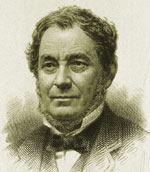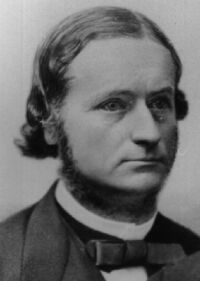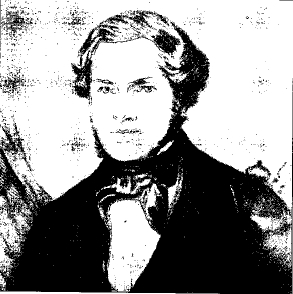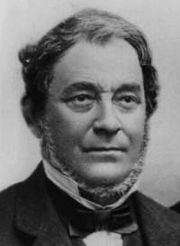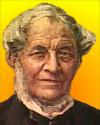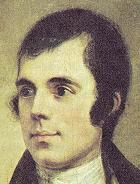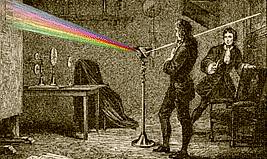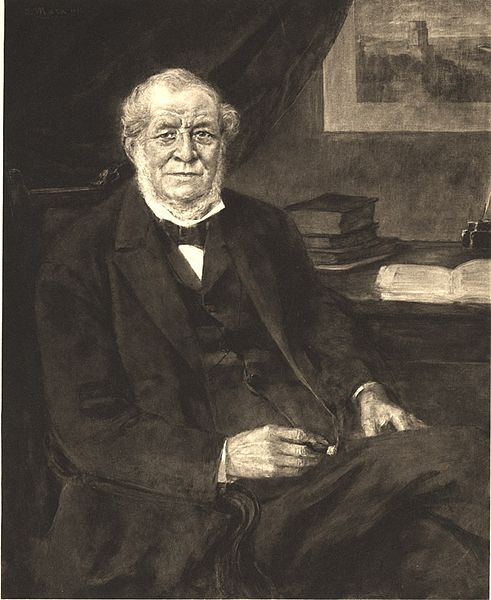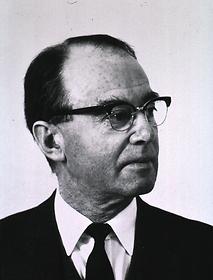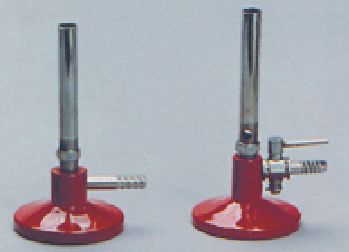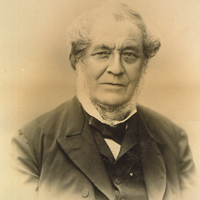Wednesday, March 30, 2011
Robert Bunsen: Google Doodle celebrates Chemist’s 200th birthday
Google Doodle celebrates the 200th birthday of popular chemist Robert Bunsen.
Google celebrates German Chemist’s 200th birthday, chemicals in bottles on today’s Google Doodle.
Google Doodle is back with another technology-related celebration. And this time, the search engine giant is celebrating the 200th birthday of German chemist Bunsen, Robert Wilhelm von, or Robert Bunsen in short.Familiar right? Bunsen might be familiar, especially if you already finished your Chemistry subject, because he invented the Bunsen burner — an apparatus inside our Chemistry laboratories.
Bunsen Burner is the thing to use if we need to produce a gas flame for heating our chemicals, as well as sterilization, and combustion. Apparently, Google Doodle’s letter G is the Bunsen Burner, very cute Google. Very cute.
Robert Bunsen also developed the first “extremely accurate” methods of gas analysis or now popularly called “Gasometric Methods.” Google used the second G to commemorate Bunsen’s gas analysis, if I’m not mistaken.
 Posted in: Events
Posted in: Events200th Birthday of Robert Wilhelm Bunsen
Robert Wilhelm Bunsen did groundbreaking work in organic chemistry and spectrometry, but he's more famous for the laboratory gas burner that bears his name.
Born on March 30, 1811 in Göttingen, Germany, Bunsen studied chemistry in Göttigen, and obtaining his Ph.D. degree in 1831. In 1833 he became a lecturer at Göttingen and three years later accepted an associate professorship at the University of Marburg. He was promoted to full professorship in 1841. In late 1852 Bunsen became the successor of Leopold Gmelin at the University of Heidelberg, Germany, where he remained until his retirement in 1889.
Bunsen investigated emission spectra of heated elements, and with Gustav Kirchhoff discovered caesium (in 1860) and rubidium (in 1861). He developed several gas-analytical methods, was a pioneer in photochemistry, and did early work in the field of organoarsenic chemistry. Among his many inventions were a grease-spot photometer, a galvanic battery, an ice calorimeter, and the spectrometer that led to the discovery of cesium and rubidium.
His most famous invention, the Bunsen burner, was created with his laboratory assistant Peter Desaga. It was designed to produce a steady and near-colorless flame, an improvement on the laboratory burners then in use. It is still one of the most commonly recognized lab tools to this day.
 Posted in: Events
Posted in: EventsRobert Bunsen Biography
When confronted by the vast array of apparatus used in chemistry lab, a student can usually identify with a high degree of confidence one of the more familiar pieces of equipment, the Bunsen burner. While this essential piece of laboratory equipment has immortalized the name of Robert Wilhelm Bunsen, it was not invented by him. Bunsen improved the burner's design to aid his endeavors in spectroscopy. Ironically, Bunsen will be remembered by generations of chemistry students for a mere improvement in a burner design, when his other contributions to the field of chemistry are vastly more significant and diverse, covering such areas as organic chemistry, arsenic compounds, gas measurements and analysis, the galvanic battery, elemental spectroscopy and geology.
Bunsen was born on March 31, 1811 in Göttingen, Germany, the youngest of four sons. As his father was a professor of modern languages at the university, an academic environment would surround him from birth. After schooling in the city of Holzminden, Bunsen studied chemistry at Göttingen. Receiving his doctorate at age 19, Bunsen set off on extensive travels, partially underwritten by the government, that took him through Germany and Paris and eventually to Vienna from 1830 to 1833. During this time, Bunsen visited Henschel's machinery manufacturing plant and saw the "new small steam engine." In Berlin, he saw the mineralogical collections of Weiss and had contact with Runge, the discoverer of aniline. Continuing on his journeys, Bunsen met with Liebig in Giessen and with Mitscherlich in Bonn for a geological trip through the Eifel mountains. In Paris and Vienna, Bunsen visited the Sevres porcelain works and met with the outstanding chemists of the times. These travels allowed Bunsen the opportunity to establish a network of contacts that would stay with him throughout his illustrious career.
Upon his return to Germany, Bunsen became a lecturer at Göttingen and began his experimental studies of the insolubility of metal salts of arsenious acid. His discovery of the use of iron oxide hydrate as a precipitating agent is still the best known antidote against arsenic poisoning to this day. This was his only venture in organic/physiological chemistry.
In 1836, Bunsen was nominated to succeed Wöhler at Kassel. He taught there for two years before accepting a position at the University of Marsburg which was the site of his important and dangerous studies of cacodyl derivatives. This research was his only work in pure organic chemistry and made him immediately famous within the scientific community. Cacodyl (from the Greek kakodhs - "stinking") was also known as alkarsine or "Cadet's liquid," a product made from arsenic distilled with potassium acetate. The chemical composition of this liquid was unknown, but it and its compounds were known to be poisonous, highly flammable and had an extremely nauseating odor even in minute quantities. Bunsen himself described one of these compounds: "the smell of this body produces instantaneous tingling of the hands and feet, and even giddiness and insensibility...It is remarkable that when one is exposed to the smell of these compounds the tongue becomes covered with a black coating, even when no further evil effects are noticeable."(1) Bunsen's daring experiments showed that cacodyl was an oxide of arsenic that contained a methyl radical (a group of atoms acting as one species). These results significantly furthered the earlier work by Gay-Lussac, who had isolated the radical cyan in 1815, and that of Liebig and Wöhler who published "One the radical of benzoic acid" in 1832. Typical of his research life, however, Bunsen seemed content to explore subjects of interest in his lab, but remained outside the fray that surrounded the often "violent" discussions of theoretical subjects. Although Bunsen's work brought him quick and wide acclaim, he nearly killed himself from arsenic poisoning and it also cost him the sight of one eye - an explosion of the compound sent a sliver of glass into his eye. Recovery was slow and painful.
While at Marsburg, Bunsen studied blast furnaces and demonstrated that over half the heat was lost in the charcoal-burning German furnaces. In British furnaces, over 80% was lost. Bunsen and a collaborator, Lyon Playfair, suggested techniques that could recycle gases through the furnace and retrieve valuable escaping by-products such as ammonia. Other work during this period concentrated on technological experiments such as the generation of galvanic currents in batteries. In 1841, instead of the expensive platinum electrode used in Grove's battery, Bunsen made a carbon electrode. This led to large scale use of the "Bunsen battery" in the production of arc-light and in electroplating.
One of the more memorable episodes during Bunsen's tenure at Marsburg was a geological trip to Iceland sponsored by the Danish government following the eruption of Mount Hekla in 1845. Indulging his lifelong interest in geology, Bunsen collected gases emitted from volcanic vents and performed extensive chemical analyses of volcanic rock. In addition to sampling lava gases, Bunsen investigated the theory of geyser action. The popular belief of his time was that the water from geysers was volcanic in origin. Bunsen took rocks from the area and boiled them in rain water. He found that the resulting solution was quite similar to geyser water. He conducted temperature studies on the water in the geyser tube at different depths and discovered that the water was indeed hot enough to boil. Due to pressure differentials caused by the moving column of water, boiling occurs in the middle of the tube and throws the mass of water above it into the sky above. In true investigative spirit Bunsen experimented with an artificial geyser in the lab:
In 1859, Bunsen suddenly discontinued his work with Roscoe, telling him:
Gustav Kirchhoff, a young Prussian physicist, had the brilliant insight to use a prism to separate the light into its constituent rays, instead of looking through colored glass to distinguish between similarly colored flames. Thus the fledgling science of spectroscopy, which would develop into a vital tool for chemical analysis, was born.In order to study the resultant spectra, however, a high temperature, nonluminous flame was necessary. An article published by Bunsen and Kirchhoff in 1860 states:
In addition to yielding a unique spectrum for each element, the spectroscope had the advantage of definite identification while only using a minimal amount of sample, on the range of nanograms to micrograms for elements like sodium and barium respectively. Using the techniques they devised, Bunsen and Kirchhoff announced the discovery of cesium (Latin caesium, "sky blue") in the following passage:
Throughout his professional life, Bunsen's personal life centered around his laboratory and his students. Never marrying, Bunsen often took on the introductory courses that were shunned by other colleagues. During the one hundred hours of lectures presented each semester, Bunsen emphasized experimentation and tabulated summaries and patiently introduced students to the world of analytical chemistry. Bunsen's habit was to assign a scientific task to his students and then to work with a student only as long as required to reach some measure of independence. Many principal players in the history of chemistry can trace their chemical roots back to Bunsen's laboratory. Two of his more famous students were Dmitri Mendeleev and Lothar Meyer.
According to accounts, Bunsen was one of the more modest of giants:
The scientific world held Bunsen in high esteem for much of his long professional life. In 1842 he was elected to the Chemical Society of London and the Academie des Sciences in 1853. He was named a foreign fellow of the Royal Society of London in 1858, receiving its Copley Medal in 1860. Bunsen and Kirchhoff were recipients of the first Davy Medal in 1877. The Albert Medal was awarded in 1898 in recognition of Bunsen's many scientific contributions to industry. Of these honors, Bunsen once remarked, "Such things had value for me only because they pleased my mother; she is now dead." (11)Upon his retirement at the age of 78, Bunsen left the chemical work behind, returned to his first love of geology, keeping up with the latest developments in the field and corresponding with his old friends such as Roscoe, Kirchhoff and Helmholtz. Bunsen died August 16, 1899 after a peaceful three day sleep, leaving behind a glowing legacy of discoveries and technological advances that allowed the world of chemistry to burn brightly.
3. Weeks, Mary E. and Leicester, Henry M. (revised), "Some Spectroscopic Discoveries," Discovery of the Elements, Journal of Chemical Education, Pennsylvania, 1968, p.598.
4. "Bunsen's Methodological Legacy", in Eduard Farber, ed., Milestones of Modern Chemistry, Basic Books, Inc., New York, 1966, p.19.
5. Lockemann, Georg, "The Centenary of the Bunsen Burner", Journal of Chemical Education, 1956, 33, 201.
6. Curtis, Theodor, "Robert Bunsen," in Eduard Farber, ed., Great Chemists, Interscience Publishers, New York, 1961, p. 579.
7. Farber, 1966, p. 24.
8. Weeks, p. 599
9. Schacher, Susan G., "Robert Bunsen," in C.C. Gillispie, ed., Dictionary of Scientific Biography, Charles Scribner's Sons, USA, 1972, p.589.
10. Curtis, p. 580.
11. Weeks, p. 605
Bunsen was born on March 31, 1811 in Göttingen, Germany, the youngest of four sons. As his father was a professor of modern languages at the university, an academic environment would surround him from birth. After schooling in the city of Holzminden, Bunsen studied chemistry at Göttingen. Receiving his doctorate at age 19, Bunsen set off on extensive travels, partially underwritten by the government, that took him through Germany and Paris and eventually to Vienna from 1830 to 1833. During this time, Bunsen visited Henschel's machinery manufacturing plant and saw the "new small steam engine." In Berlin, he saw the mineralogical collections of Weiss and had contact with Runge, the discoverer of aniline. Continuing on his journeys, Bunsen met with Liebig in Giessen and with Mitscherlich in Bonn for a geological trip through the Eifel mountains. In Paris and Vienna, Bunsen visited the Sevres porcelain works and met with the outstanding chemists of the times. These travels allowed Bunsen the opportunity to establish a network of contacts that would stay with him throughout his illustrious career.
Upon his return to Germany, Bunsen became a lecturer at Göttingen and began his experimental studies of the insolubility of metal salts of arsenious acid. His discovery of the use of iron oxide hydrate as a precipitating agent is still the best known antidote against arsenic poisoning to this day. This was his only venture in organic/physiological chemistry.
In 1836, Bunsen was nominated to succeed Wöhler at Kassel. He taught there for two years before accepting a position at the University of Marsburg which was the site of his important and dangerous studies of cacodyl derivatives. This research was his only work in pure organic chemistry and made him immediately famous within the scientific community. Cacodyl (from the Greek kakodhs - "stinking") was also known as alkarsine or "Cadet's liquid," a product made from arsenic distilled with potassium acetate. The chemical composition of this liquid was unknown, but it and its compounds were known to be poisonous, highly flammable and had an extremely nauseating odor even in minute quantities. Bunsen himself described one of these compounds: "the smell of this body produces instantaneous tingling of the hands and feet, and even giddiness and insensibility...It is remarkable that when one is exposed to the smell of these compounds the tongue becomes covered with a black coating, even when no further evil effects are noticeable."(1) Bunsen's daring experiments showed that cacodyl was an oxide of arsenic that contained a methyl radical (a group of atoms acting as one species). These results significantly furthered the earlier work by Gay-Lussac, who had isolated the radical cyan in 1815, and that of Liebig and Wöhler who published "One the radical of benzoic acid" in 1832. Typical of his research life, however, Bunsen seemed content to explore subjects of interest in his lab, but remained outside the fray that surrounded the often "violent" discussions of theoretical subjects. Although Bunsen's work brought him quick and wide acclaim, he nearly killed himself from arsenic poisoning and it also cost him the sight of one eye - an explosion of the compound sent a sliver of glass into his eye. Recovery was slow and painful.
While at Marsburg, Bunsen studied blast furnaces and demonstrated that over half the heat was lost in the charcoal-burning German furnaces. In British furnaces, over 80% was lost. Bunsen and a collaborator, Lyon Playfair, suggested techniques that could recycle gases through the furnace and retrieve valuable escaping by-products such as ammonia. Other work during this period concentrated on technological experiments such as the generation of galvanic currents in batteries. In 1841, instead of the expensive platinum electrode used in Grove's battery, Bunsen made a carbon electrode. This led to large scale use of the "Bunsen battery" in the production of arc-light and in electroplating.
One of the more memorable episodes during Bunsen's tenure at Marsburg was a geological trip to Iceland sponsored by the Danish government following the eruption of Mount Hekla in 1845. Indulging his lifelong interest in geology, Bunsen collected gases emitted from volcanic vents and performed extensive chemical analyses of volcanic rock. In addition to sampling lava gases, Bunsen investigated the theory of geyser action. The popular belief of his time was that the water from geysers was volcanic in origin. Bunsen took rocks from the area and boiled them in rain water. He found that the resulting solution was quite similar to geyser water. He conducted temperature studies on the water in the geyser tube at different depths and discovered that the water was indeed hot enough to boil. Due to pressure differentials caused by the moving column of water, boiling occurs in the middle of the tube and throws the mass of water above it into the sky above. In true investigative spirit Bunsen experimented with an artificial geyser in the lab:
"To confirm his theory, Bunsen made an artificial geyser, consisting of a basin of water having a long tube extending below it. He heated the tube at the bottom andat about the middlepoint. As the water at the middle reached its boiling point, all of the phenomena of geyser action were beautifully shown, including the preliminary thundering. That was in 1846. From that day to this Bunsen's theory of geyser action has been generally accepted by geologists."(2)In 1852 Bunsen succeeded Leopold Gmelin at Heidelberg. His stature was such that he attracted students and chemists from all over the world to study in his laboratory. Again, Bunsen ignored the current trend in organic chemistry which was fast overtaking the experimental world. Instead, Bunsen improved his earlier work on batteries: using chromic acid instead of nitric acid, he was able to produce pure metals such as chromium, magnesium, aluminum, manganese, sodium, aluminum, barium, calcium and lithium by electrolysis. Bunsen devised a sensitive ice calorimeter that measured the volume rather than the mass of the ice melted. This allowed him to measure the metals' specific heat to find their true atomic weights. During this period, he also pressed magnesium into wire; the element came into general use as an outstanding illuminating agent.A former student of Bunsen's believes that it was this "splendid light" from the combustion of magnesium that led Bunsen to devote considerable attention to photochemical studies. A ten year collaboration with Sir Henry Roscoe began in 1852. They took equal volumes of gaseous hydrogen and chlorine and studied the formation of HCl, which occurs in specific relationship to the amount of light received. Their results showed that the light radiated from the sun per minute was equivalent to the chemical energy of 25 x 1012 mi3 of a hydrogen-chlorine mixture forming HCl.
In 1859, Bunsen suddenly discontinued his work with Roscoe, telling him:
At present Kirchhoff and I are engaged in a common work which doesn't let us sleep...Kirchhoff has made a wonderful, entirely unexpected discovery in finding the cause of the dark lines in the solar spectrum....thus a means has been found to determine the composition of the sun and fixed stars with the same accuracy as we determine sulfuric acid, chlorine, etc., with our chemical reagents. Substances on the earth can be determined by this method just as easily as on the sun, so that, for example, I have been able to detect lithium in twenty grams of sea water."(3)
"The lines show up the more distinctly the higher the temperature and the lower the luminescence of the flame itself. The gas burner described by one of us has a flame of very high temperature and little luminescence and is, therefore, particularly suitable for experiments on the bright lines that are characteristic for these substances."(4)The burner described was quickly dubbed the "Bunsen burner," although the apparatus is not of his design. The concept to premix the gas and air prior to combustion in order to yield the necessary high temperature, nonluminous flame belongs to Bunsen. Credit for the actual design and manufacture of the burner goes to Peter Desaga, a technician at the University of Heidelburg. (5)Within five years of the development of the burner, Bunsen and Kirchhoff were deeply involved with spectroscopy, inventing yet another instrument: the Bunsen-Kirchhoff spectroscope. This vital instrument of chemical analysis can trace its ancestry to such simple components as a "prism, a cigar box, and two ends of otherwise unusable old telescopes."(6) From such humble beginnings came the instrument which proved to be of tremendous importance in chemical analysis and the discovery of new elements.
In addition to yielding a unique spectrum for each element, the spectroscope had the advantage of definite identification while only using a minimal amount of sample, on the range of nanograms to micrograms for elements like sodium and barium respectively. Using the techniques they devised, Bunsen and Kirchhoff announced the discovery of cesium (Latin caesium, "sky blue") in the following passage:
"Supported by unambiguous results of the spectral-analytical method, we believe we can state right now that there is a fourth metal in the alkali group besides potassium, sodium, and lithium, and it has a simple characteristic spectrum like lithium; a metal that shows only two lines in our apparatus: a faint blue one, almost coinciding with Srd, and another blue one a little further to the violet end of the spectrum and as strong and as clearly defined as the lithium line."(7)Some of Bunsen's enthusiasm is readily apparent in a letter to Roscoe dated November 6, 1869:
"I have been very fortunate with my new metal...I shall name it cesium because of its beautiful blue spectral line. Next Sunday I expect to find time to make the first determination of its atomic weight." (8)In 1861, only a few months following their cesium discovery, Bunsen and Kirchhoff announced the discovery of yet another new alkali metal. Two hitherto undiscovered violet spectral lines in an alkali of the mineral lepidolite were attributed to a new element, rubidium (Latin rubidus, "darkest red colour").Bunsen and Kirchhoff's combined genius quickly paved the way for others to claim elemental discoveries. The spectroscope served as a springboard by which five new elements were discovered. These included thallium (Crookes, 1861), indium (Reich and Richter, 1863), gallium (Lecoq de Boisbaudran, 1875), scandium (Nilson, 1879) and germanium (Winkler, 1886).(9) Fittingly, Bunsen's original vision of analyzing the composition of the stars was realized in 1868 when helium was discovered in the solar spectrum.
Throughout his professional life, Bunsen's personal life centered around his laboratory and his students. Never marrying, Bunsen often took on the introductory courses that were shunned by other colleagues. During the one hundred hours of lectures presented each semester, Bunsen emphasized experimentation and tabulated summaries and patiently introduced students to the world of analytical chemistry. Bunsen's habit was to assign a scientific task to his students and then to work with a student only as long as required to reach some measure of independence. Many principal players in the history of chemistry can trace their chemical roots back to Bunsen's laboratory. Two of his more famous students were Dmitri Mendeleev and Lothar Meyer.
According to accounts, Bunsen was one of the more modest of giants:
"He never said: 'I have discovered,' or 'I found'...He was characterized by extraordinary, distinguished modesty. That does not mean that he was not conscious of his own value. He knew how to use it at the right time and in the right company; he even had a considerable degree of very sound egotism." (10)
Footnotes
1. Davenport, Derek, "Robert Bunsen...more than a burner design," ChemMatters, 1984, 2, p. 14.2. Darrow, Floyd, Masters of Science and Invention , Harcourt, Brace and Company, Inc., New York, 1923, p.212.3. Weeks, Mary E. and Leicester, Henry M. (revised), "Some Spectroscopic Discoveries," Discovery of the Elements, Journal of Chemical Education, Pennsylvania, 1968, p.598.
4. "Bunsen's Methodological Legacy", in Eduard Farber, ed., Milestones of Modern Chemistry, Basic Books, Inc., New York, 1966, p.19.
5. Lockemann, Georg, "The Centenary of the Bunsen Burner", Journal of Chemical Education, 1956, 33, 201.
6. Curtis, Theodor, "Robert Bunsen," in Eduard Farber, ed., Great Chemists, Interscience Publishers, New York, 1961, p. 579.
7. Farber, 1966, p. 24.
8. Weeks, p. 599
9. Schacher, Susan G., "Robert Bunsen," in C.C. Gillispie, ed., Dictionary of Scientific Biography, Charles Scribner's Sons, USA, 1972, p.589.
10. Curtis, p. 580.
11. Weeks, p. 605
 Posted in: Famous Personalities
Posted in: Famous PersonalitiesRobert Bunsen Achievements
This edited article about Robert Wilhelm Eberhard Bunsen originally appeared in Look and Learn issue number 917 published on 18 August 1979.
When a new laboratory was built at Heidelberg, in Germany, in 1855, a chemist was asked to look at the various devices proposed for the supply of heat for chemical experiments. A blowlamp was generally used for these, but the scientist wanted something more convenient to handle.
Finding nothing to suit him, he soon devised a simple means of burning ordinary coal gas with a hot, smokeless flame. His burner was such a good and easy means of obtaining an intense heat that within a short time it became widely used in laboratories. And it remains in use today.
The chemist was Robert Wilhelm Eberhard Bunsen and the device he invented, the bunsen burner, was just one of his many achievements.
The youngest of four sons born to Christian Bunsen, a Prussian diplomat and scholar, Robert was born on 31st March, 1811.
He was educated at Göttingen University, where he studied chemistry, physics, mineralogy, and mathematics. After graduating, Bunsen toured Europe for three years. He visited factories, laboratories and places of geological interest. In October, 1838, he was appointed Professor of Chemistry at Marburg. Subsequently, he spent some time at Breslau, where he met Gustav Kirchoff, with whom he later did important research in spectroscopy.
Appointed to the university of Heidelberg in 1852, Bunsen remained until he retired in 1889 at the age of 78. During this time, as the mastermind at Heidelberg, he made this university one of the great scientific centres of Europe.
Bunsen had begun his first important research at the age of 26, and for six years he had studied compounds of arsenic. In discovering an antidote to arsenical poisoning, he lost the sight of an eye through an explosion. His experiences sapped his enthusiasm for this work, and he left his researches to be carried on by a pupil.
Bunsen had also taken up at the beginning of his career the study of gases given off by blast furnaces. This proved to be of immediate and practical importance. He was able to show that in German furnaces almost half the heat yielded by the fuel was allowed to escape with the waste gases.
Going to Britain to investigate the furnaces, he revolutionised Britain’s methods of producing iron by pointing out that 80 per cent of the heat went up the chimney with the waste fumes, whilst valuable by-products like ammonia were among the gases lost to the atmosphere.
He was able to suggest techniques that could recycle the gases through the furnaces, so using heat that would otherwise be lost. Ways of retrieving valuable escaping materials were also suggested by Bunsen.
Bunsen published his research in his only book Gasometrische Methoden in 1857.
A devoted teacher, Bunsen presented a hundred hours of lectures during each of 74 terms in a course on inorganic chemistry. These kept theoretical aspects to a minimum, for Bunsen was an enthusiast for experimentation. He enjoyed designing apparatus and, being a skilled glassblower, he frequently made his own laboratory glassware. He was also interested in the application of experimental science to industrial problems and he devoted a lot of interest to geology.
In 1841 he ventured into the borderland between chemistry and electricity, as a result of which he invented the carbon-zinc electric cell, also known by his name. By using it to produce an electric arc he obtained, out of a pound of zinc, a light equal to 1,171 candles. Each pound of zinc used in the batteries lasted an hour. Then to measure exactly the candle power of the light he had obtained, Bunsen invented a simple device called a grease-spot photometer.
This uses a white screen with a grease spot at its centre. The sources of light are mounted at opposite sides of the screen. The positions of the lamps are adjusted until the grease spot is no longer distinguishable. The candlepowers can be worked out by squaring the distances of the lamps from the screen.
In 1852 Bunsen began to use his battery in another ingenious way. He passed a current through various solutions, and by so doing separated the constituents. By this means he obtained magnesium in its metallic state and turned his discovery into great significance for photographers by demonstrating the brilliance of magnesium when burnt. He showed how quickly it acted on a photographic plate. Before this, however, he had been able to indulge his interest in geology by accompanying a scientific expedition to Iceland in 1846, the year after the eruption of the volcano Hekla. Sponsored by the Danish government, the expedition lasted nearly four months.
During this time, Bunsen collected gases emitted from the volcanic openings and studied the action of these gases on volcanic rocks. He performed extensive chemical analyses of eruptive rocks, insisting that instead of determining what minerals were in the rock, it was the chemical composition of the rock as a whole which should be ascertained.
Bunsen also explored geysers and made temperature measurements at several depths shortly before one erupted. He found that the temperature of the water in the geyser tube, although high, did not reach boiling point.
He concluded that the driving force for an eruption was supplied by steam that entered the tube under great pressure from volcanic vents at the bottom. As the steam lifted the column of water, the pressure above the water was reduced. This change in the water’s depth results in a lowering of the boiling point and enables the already hot water to boil.
Perhaps it was on this trip that Bunsen gained the idea which enabled him to develop his well-known burner. In analytical chemistry, the burner quickly ousted the blowlamp.
Bunsen also used his burner to identify metals and their salts by their characteristic coloured flames. Other experiments with the burner yielded data for the melting points of metals and rate of evaporation of salts.
In fact, Bunsen was continuously successful as a man of science. In 1868 he worked out methods for separating the metals palladium, ruthenium, iridium, and rhodium that remain in ores after the extraction of platinum, and as part of this project Bunsen constructed a filter pump.
After many other experiments and discoveries he was, in 1842, elected a member of the Chemical Society of London and, in 1882, of the Académie des Sciences of France. The Royal Society honoured him with its Copley medal in 1860 and he received the first Davy Medal in 1877. Finally, Bunsen’s scientific contributions to industry were recognised by Britain’s Society of Arts, which awarded him the Albert Medal in 1898.
On 16th August of the following year, Bunsen died at Heidelberg, which he had helped to make famous and which had provided him with the opportunity for the invention which has earned him immortality.
Another of his achievements was so tremendously important that it dwarfs all others. Following a strange discovery made by a fellow worker in 1860, he took a main part in the work of finding out the significance of the thousands of faint dark lines on the band of colour formed by passing sunlight through a prism. By developing his methods it was possible, in the era before space travel, to get photographs of ion-storms and other masses of flaming elements on the sun.
This success was far more illuminating than his burner flame.
 Posted in: Science
Posted in: ScienceRobert Bunsen Inventions
Key accomplishments: toxicology
1702
Richard Mead
First Publication on Poisons
Richard Mead's A Mechanical Account of Poisons in Several Essays is the first book in English devoted entirely to the discussion of poisons.
1752
First Chemical Tests in a Trial
The Mary Blandy case in England is the first reported use of chemical tests to detect arsenic in a legal trial.
1814
Mathieu Orfila
First Toxicology Publication
In France, Mathieu Orfila's Traité des Poisons is the first book devoted entirely to the subject of toxicology. Orfila popularizes the word "toxicology."
1836
James Marsh
Marsh Test Devised
English chemist James Marsh devises a test for identifying trace amounts of arsenic.
1851
Jean-Servais Stas
Alkaloid Poison Test Developed
Belgian chemist Jean-Servais Stas develops a method for detecting vegetable alkaloid poisons (caffeine, quinine, morphine, strychnine, atropine, opium) in dead bodies.
1860
Robert Wilhelm Eberhard Bunsen and Gustav Robert Kirchhoff
Spectrum Analysis Developed
With the aid of the spectroscope, which they invented in 1859, German chemist Robert Bunsen and physicist Gustav Kirchhoff discover that vaporizing a substance creates a unique "signature" spectrum, which can be used to identify it. Using the spectroscope, in 1860, Bunsen and Kirchhoff discover two new alkali metals—cesium and rubidium.
1906
Mikhail Tswett
Paper Chromatography Developed
Italian-born Russian botanist Mikhail Tswett invents paper chromatography, initially to study the make-up of plant proteins such as chlorophyll.
1926
Theodor Svedberg
Ultracentrifuge Developed
Swedish chemist Theodor Svedberg builds the first ultracentrifuge—a machine that separates particles by mass—making it possible to determine precisely the molecular weights of highly complex proteins. Svedberg wins the Nobel Prize for Chemistry in 1926 for his invention of the ultracentrifuge and studies in the chemistry of colloids.
1941
Arnold Beckman, Howard Cary and Warren Baxter at National Technical Laboratories (now Beckman Coulter)
Ultraviolet Spectrophotometer Introduced
The Beckman model DU spectrophotometer is the first instrument to probe the ultraviolet region with high precision and accuracy. According to Bruce Merrifield, Nobel Laureate in chemistry, the DU is "probably the most important instrument ever developed in the advancement of bioscience."
1948
Arne Tiselius
Electrophoresis and Adsorption Developed
During the 1920s and 1930s, Swedish chemist Arne Tiselius helps develop and improve electrophoresis and analysis by adsorption. In 1948, he receives the Nobel Prize in Chemistry for his work.
1950s
New Technologies Incorporated
Ultraviolet and infrared spectrometry, X-ray diffraction, and paper chromatography are applied to forensic science.
1952
Richard L. M. Synge and Archer J. P. Martin
Partition Chromatography Developed
British biochemists Archer J. P. Martin and Richard L. M. Synge demonstrate partition chromatography to the Biochemical Society at a 1941 meeting in London. They share the Nobel Prize in Chemistry in 1952 for their development of partition chromatography.
1953
Gas Chromatography Developed
The first commercial gas chromatograph is manufactured.
1966
New Technologies Incorporated
Fourier-transformed infrared spectroscopy (FTIR), a technique that measures various infrared wavelengths, and atomic absorption spectroscopy, which uses the absorption of light to measure the concentration of gas-phase atoms, are invented.
 Posted in: Science
Posted in: ScienceRobert Bunsen Burner
Bunsen Burner Dimensions
The Bunsen burner is a type of laboratory equipment  utilized for combustion and sterilization. It does this by generating a solitary gas flame. It is named after its inventor, Robert Bunsen.
utilized for combustion and sterilization. It does this by generating a solitary gas flame. It is named after its inventor, Robert Bunsen.
 utilized for combustion and sterilization. It does this by generating a solitary gas flame. It is named after its inventor, Robert Bunsen.
utilized for combustion and sterilization. It does this by generating a solitary gas flame. It is named after its inventor, Robert Bunsen. Bunsen Burner Dimensions
There are slight variations in the size depending on how the equipment was designed. For example, there are Bunsen burners that measure 4.1" W x 1.9" H x 5.1" D (103 x 49 x 130 mm).
Others measure 5.1" W x 2.9" H x 6.1" D, and still others 4.5" W x 2.5" H x 5.5" D. The burner shaft cover also varies, with some coming at 23 mm and others at 25 mm, 28 mm and other sizes. The burner usually weighs anywhere from a pound to two pounds.
Features and Usage
While the Bunsen burner dimensions vary, they will use either natural gas (methane) or LPG (liquefied petroleum gas). In some instances, the burner will use a combination of the two. The hose barb is hooked to the gas nozzle at the lab bench which has rubber tubing.
Majority of these benches have several gas nozzles linked to a central gas source, steam nozzles, nitrogen and vacuum. The gas goes through the base via a small opening. The opening is at the barrel’s bottom. This is pointed upward. Open slots are on the tube’s side bottom. This is to allow air to get to the stream.
Lighting Methods and Combustion Reaction
Whatever the Bunsen burner dimensions are, the most wisely used techniques for lighting is a spark lighter or match. The oxygen amount combined with the gas influences the combustion reaction.
Less air means an incomplete and cooler reaction. The airflow can be managed by the closing or opening of the slots at the barrel’s base. In many ways this is a lot like the choke in the carburetor.
Safety and Blue Flames
An adjustment of the collar at the tube will let more air into the gas. This will result in a hotter flame. This will be apparent by the blue color. Closed holes mean gas mixes with ambient air during combustion. This generates a brighter but cooler yellow.
This is known as a luminous or safety flame. The luminous color is brought about by the soot particles. The yellow flame is regarded as dirty since it leaves behind carbon on anything it is heated on.
If the Bunsen burner is set up to generate blue flame, keep in mind that it can be difficult to see in some backgrounds. The hottest component of the flame is the inner flame’s tip. The coolest portion is the entire inner flame.
By boosting the fuel gas flow the dimensions of the flame will go up. Unless the adjustment is correct however, the flame may get cooler because the flame is losing oxygen. The blue flame’s hottest part is over the unburned gas.
Whatever the Bunsen burner dimensions used, it is imperative that the burner be set on a heat resistant mat prior to lighting it. This will prevent the lab bench from burning up.
 Posted in: Science
Posted in: ScienceRobert Wilhelm Bunsen (1811-1899)
Bunsen was born on March 31, 1811 in Göttingen, Germany, the youngest of four sons. As his father was a professor of modern languages at the university, an academic environment would surround him from birth. After schooling in the city of Holzminden, Bunsen studied chemistry at Göttingen. Receiving his doctorate at age 19, Bunsen set off on extensive travels, partially underwritten by the government, that took him through Germany and Paris and eventually to Vienna from 1830 to 1833. During this time, Bunsen visited Henschel's machinery manufacturing plant and saw the "new small steam engine." In Berlin, he saw the mineralogical collections of Weiss and had contact with Runge, the discoverer of aniline. Continuing on his journeys, Bunsen met with Liebig in Giessen and with Mitscherlich in Bonn for a geological trip through the Eifel mountains.
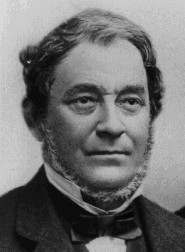 | The essential piece of laboratory equipment that has immortalized the name of Robert Wilhelm Bunsen was not invented by him. Bunsen improved the burner's to aid his endeavors in spectroscopy. Ironically, Bunsen will be remembered by generations of chemistry students for a mere improvement in a burner , when his other contributions to the field of chemistry are vastly more significant and diverse, covering such areas as organic chemistry, arsenic compounds, gas measurements and analysis, the galvanic battery, elemental spectroscopy and geology.In Paris and Vienna, Bunsen visited the Sevres porcelain works and met with the outstanding chemists of the times. These travels allowed Bunsen the opportunity to establish a network of contacts that would stay with him throughout his illustrious career. |
Bunsen's daring experiments showed that cacodyl was an oxide of arsenic that contained a methyl radical (a group of atoms acting as one species). These results significantly furthered the earlier work by Gay-Lussac, who had isolated the radical cyan in 1815, and that of Liebig and Wöhler who published "One the radical of benzoic acid" in 1832. Typical of his research life, however, Bunsen seemed content to explore subjects of interest in his lab, but remained outside the fray that surrounded the often "violent" discussions of theoretical subjects. Although Bunsen's work brought him quick and wide acclaim, he nearly killed himself from arsenic poisoning and it also cost him the sight of one eye - an explosion of the compound sent a sliver of glass into his eye.
While at Marsburg, Bunsen studied blast furnaces and demonstrated that over half the heat was lost in the charcoal-burning German furnaces. In British furnaces, over 80% was lost. Bunsen and a collaborator, Lyon Playfair, suggested techniques that could recycle gases through the furnace and retrieve valuable escaping by-products such as ammonia. Other work during this period concentrated on technological experiments such as the generation of galvanic currents in batteries. In 1841, instead of the expensive platinum electrode used in Grove's battery, Bunsen made a carbon electrode. This led to large scale use of the "Bunsen battery" in the production of arc-light and in electroplating.
One of the more memorable episodes during Bunsen's tenure at Marsburg was a geological trip to Iceland sponsored by the Danish government following the eruption of Mount Hekla in 1845. Indulging his lifelong interest in geology, Bunsen collected gases emitted from volcanic vents and performed extensive chemical analyses of volcanic rock. In addition to sampling lava gases, Bunsen investigated the theory of geyser action. The popular belief of his time was that the water from geysers was volcanic in origin. Bunsen took rocks from the area and boiled them in rain water. He found that the resulting solution was quite similar to geyser water. He conducted temperature studies on the water in the geyser tube at different depths and discovered that the water was indeed hot enough to boil. Due to pressure differentials caused by the moving column of water, boiling occurs in the middle of the tube and throws the mass of water above it into the sky above. In true investigative spirit Bunsen experimented with an artificial geyser in the lab:
"To confirm his theory, Bunsen made an artificial geyser, consisting of a basin of water having a long tube extending below it. He heated the tube at the bottom andat about the middlepoint. As the water at the middle reached its boiling point, all of the phenomena of geyser action were beautifully shown, including the preliminary thundering. That was in 1846. From that day to this Bunsen's theory of geyser action has been generally accepted by geologists."
In 1852 Bunsen succeeded Leopold Gmelin at Heidelberg. His stature was such that he attracted students and chemists from all over the world to study in his laboratory. Again, Bunsen ignored the current trend in organic chemistry which was fast overtaking the experimental world. Instead, Bunsen improved his earlier work on batteries: using chromic acid instead of nitric acid, he was able to produce pure metals such as chromium, magnesium, aluminum, manganese, sodium, aluminum, barium, calcium and lithium by electrolysis. Bunsen devised a sensitive ice calorimeter that measured the volume rather than the mass of the ice melted. This allowed him to measure the metals' specific heat to find their true atomic weights. During this period, he also pressed magnesium into wire. The element came into general use as an outstanding illuminating agent.
A former student of Bunsen's believes that it was this "splendid light" from the combustion of magnesium that led Bunsen to devote considerable attention to photochemical studies. A ten year collaboration with Sir Henry Roscoe began in 1852. They took equal volumes of gaseous hydrogen and chlorine and studied the formation of HCl, which occurs in specific relationship to the amount of light received. Their results showed that the light radiated from the sun per minute was equivalent to the chemical energy of 25 x 1012 mi3 of a hydrogen-chlorine mixture forming HCl. In 1859, Bunsen suddenly discontinued his work with Roscoe, telling him:
At present Kirchhoff and I are engaged in a common work which doesn't let us sleep...Kirchhoff has made a wonderful, entirely unexpected discovery in finding the cause of the dark lines in the solar spectrum....thus a means has been found to determine the composition of the sun and fixed stars with the same accuracy as we determine sulfuric acid, chlorine, etc., with our chemical reagents. Substances on the earth can be determined by this method just as easily as on the sun, so that, for example, I have been able to detect lithium in twenty grams of seawater."
Gustav Kirchhoff, a young Prussian physicist, had the brilliant insight to use a prism to separate the light into its constituent rays, instead of looking through colored glass to distinguish between similarly colored flames. Thus the fledgling science of spectroscopy, which would develop into a vital tool for chemical analysis, was born. In order to study the resultant spectra, however, a high temperature, nonluminous flame was necessary. An article published by Bunsen and Kirchhoff in 1860 states:
"The lines show up the more distinctly the higher the temperature and the lower the luminescence of the flame itself. The gas burner described by one of us has a flame of very high temperature and little luminescence and is, therefore, particularly suitable for experiments on the bright lines that are characteristic for these substances."
The burner described was quickly dubbed the "Bunsen burner," although the apparatus is not of his design. The concept to premix the gas and air prior to combustion in order to yield the necessary high temperature, nonluminous flame belongs to Bunsen. Credit for the actual design and manufacture of the burner goes to Peter Desaga, a technician at the University of Heidelburg. Within five years of the development of the burner, Bunsen and Kirchhoff were deeply involved with spectroscopy, inventing yet another instrument: the Bunsen-Kirchhoff spectroscope. This vital instrument of chemical analysis can trace its ancestry to such simple components as a "prism, a cigar box, and two ends of otherwise unusable old telescopes." From such humble beginnings came the instrument which proved to be of tremendous importance in chemical analysis and the discovery of new elements.
In addition to yielding a unique spectrum for each element, the spectroscope had the advantage of definite identification while only using a minimal amount of sample, on the range of nanograms to micrograms for elements like sodium and barium respectively. Using the techniques they devised, Bunsen and Kirchhoff announced the discovery of cesium (Latin caesium, "sky blue") in the following passage:
"Supported by unambiguous results of the spectral-analytical method, we believe we can state right now that there is a fourth metal in the alkali group besides potassium, sodium, and lithium, and it has a simple characteristic spectrum like lithium; a metal that shows only two lines in our apparatus: a faint blue one, almost coinciding with Srd, and another blue one a little further to the violet end of the spectrum and as strong and as clearly defined as the lithium line."
In 1861, only a few months following their cesium discovery, Bunsen and Kirchhoff announced the discovery of yet another new alkali metal. Two hitherto undiscovered violet spectral lines in an alkali of the mineral lepidolite were attributed to a new element, rubidium. Bunsen and Kirchhoff's combined genius quickly paved the way for others to claim elemental discoveries. The spectroscope served as a springboard by which five new elements were discovered. These included thallium (Crookes, 1861), indium (Reich and Richter, 1863), gallium (Lecoq de Boisbaudran, 1875), scandium (Nilson, 1879) and germanium (Winkler, 1886). Fittingly, Bunsen's original vision of analyzing the composition of the stars was realized in 1868 when helium was discovered in the solar spectrum.
Throughout his professional life, Bunsen's personal life centered around his laboratory and his students. Never marrying, Bunsen often took on the introductory courses that were shunned by other colleagues. During the one hundred hours of lectures presented each semester, Bunsen emphasized experimentation and tabulated summaries and patiently introduced students to the world of analytical chemistry. Bunsen's habit was to assign a scientific task to his students and then to work with a student only as long as required to reach some measure of independence. Many principal players in the history of chemistry can trace their chemical roots back to Bunsen's laboratory. Two of his more famous students were Dmitri Mendeleev and Lothar Meyer. According to accounts, Bunsen was one of the more modest of giants:
"He never said: 'I have discovered,' or 'I found'...He was characterized by extraordinary, distinguished modesty. That does not mean that he was not conscious of his own value. He knew how to use it at the right time and in the right company; he even had a considerable degree of very sound egotism."
The scientific world held Bunsen in high esteem for much of his long professional life. In 1842 he was elected to the Chemical Society of London and the Academie des Sciences in 1853. He was named a foreign fellow of the Royal Society of London in 1858, receiving its Copley Medal in 1860. Bunsen and Kirchhoff were recipients of the first Davy Medal in 1877. The Albert Medal was awarded in 1898 in recognition of Bunsen's many scientific contributions to industry. Of these honors, Bunsen once remarked,"Such things had value for me only because they pleased my mother; she is now dead."
Upon his retirement at the age of 78, Bunsen left the chemical work behind, returned to his first love of geology, keeping up with the latest developments in the field and corresponding with his old friends such as Roscoe, Kirchhoff and Helmholtz. Bunsen died August 16, 1899 after a peaceful three day sleep, leaving behind a glowing legacy of discoveries and technological advances that allowed the world of chemistry to burn brightly. (reference: http://step.sdsc.edu/projects95/chem.in.history/essays/bunsen.html)
 Posted in: History
Posted in: HistoryRobert Bunsen's 200th BirthDay Anniversary
The 31st of March 2011 marks the 200th anniversary of the birth of Robert Bunsen (1811-1899). Bunsen was a German chemist perhaps most famous for his invention of the Bunsen Burner; this was actually the latest in a series of improvements to the laboratory burners already in use but proved to be the most effective and came to make his name familiar to every young student of the chemical sciences.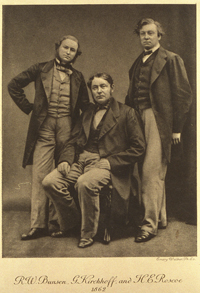
Robert Bunsen was one of the most influential chemistry teachers of his time, teaching at the Universities in Marburg, Breslau & Heidelberg as well as the Polytechnic School of Kassel. Some of his more notable students included Henry Roscoe, Friedrich Beilstein, John Tyndall, Edward Frankland and Dmitri Mendeleev (creator of the Periodic Table).
With Gustav Kirchhoff, Robert Bunsen pioneered the use of spectroscopy in chemical analysis; Spectroscopy is the study of the interaction between matter and radiated energy, i.e. when an element is heated, it emits energy in the form of light, this light can then be examined with a spectroscope to determine its unique spectra. Kirchhoff and Bunsen used this process to eventually discover Caesium and Rubidium.

Bunsen, Kirchhoff & Roscoe (1862) |
The RSC archive holds many items written by and about Robert Bunsen. These include the handwritten 'Photochemical Researches' (c. 1851) conducted by him and Sir Henry Roscoe as well as 'Roscoe's Lectures on Bunsen's and Kirchhoff's Spectrum Observations' (1861) and letters written by Bunsen to Roscoe.
Roscoe and Bunsen were to become lifelong friends as well as collaborators in research, Roscoe said of Bunsen:
'As an investigator he was great, as a teacher he was greater, as a man and friend he was greatest'
Bunsen never married and devoted most of his time to his research and his teaching. It is clear that he was extremely popular and well-liked by both his contemporaries and his students. After meeting Bunsen for the first time, Agnes Fischer, the wife of Emil Fischer (another notable German chemist) said,
'First, I would like to wash Bunsen, and then I would like to kiss him because he is such a charming man'
Further Reading
Bunsen, R. 1859, On the Chemical Theory of Gunpowder, Royal Artillery Institution, London (RSC Item ID: HC1855)
Partington, J.R. 1957, Short History of Chemistry, Macmillan & Co., London (RSC Item ID: 24011)
Roscoe, H.E. 1900, 'Bunsen Memorial Lecture', Journal of the Chemical Society, Transactions, vol. 77, pp. 513-554 (See journal link below)
Roscoe, H.E. 1900, Bunsen: A Discourse (delivered at the Royal Institution Friday June 1, 1900, Royal Institution, London (RSC Item ID: HC3389)
Roscoe, H.E. 1906, The Life and Experiences of Sir Henry Enfield Roscoe,Macmillan, London (RSC Item ID: 100068)
 Posted in: Famous Personalities
Posted in: Famous PersonalitiesRobert Bunsen and Gustav Kirchoff
 |
| Robert Bunsen (centrum), Gustav Kirchhoff (odešel) a Sir Henry Roscoe (pravý) u Manchester univerzita v 1862 |
 |
| Gustav Kirchhoff (left) and Robert Bunsen (right) |
 |
| Kirchoff (left) and Bunsen. Reproduced courtesy of the Library and Information Centre, The Royal Society of Chemistry. |
Robert Bunsen and Gustav Kirchoff
In 1861 Bunsen and Kirchoff jointly discovered caesium (which gave a blue flame) and rubidium (which gave a red flame). Bunsen (who devised, or at least developed, the Bunsen burner) discovered only two elements himself, along with Kirchoff, but his technique was used to discover several more. |
Robert Bunsen |
 Posted in: Famous Personalities
Posted in: Famous Personalities

